Exclusive survey: Windows 11 will be adopted rapidly, a lot of users going for touch devices
Here are the top five takeaways from what users think of Windows 11, after almost two months since the unveil:
- More than half of users polled will actually update to Windows 11 right away, despite the wave of denial online.
- Microsoft’s system requirements fall heavy, as a quarter of users don’t pass the official test.
- A third of respondents are willing to switch to a touch-based device, once Windows 11 gets out. When it comes to Windows 7 users, that percentage jumps to 46%.
- The centered Start Menu is actually liked by more than a third of users.
- Windows 11 convinced 17% of respondents become Microsoft insiders just to test it out sooner.
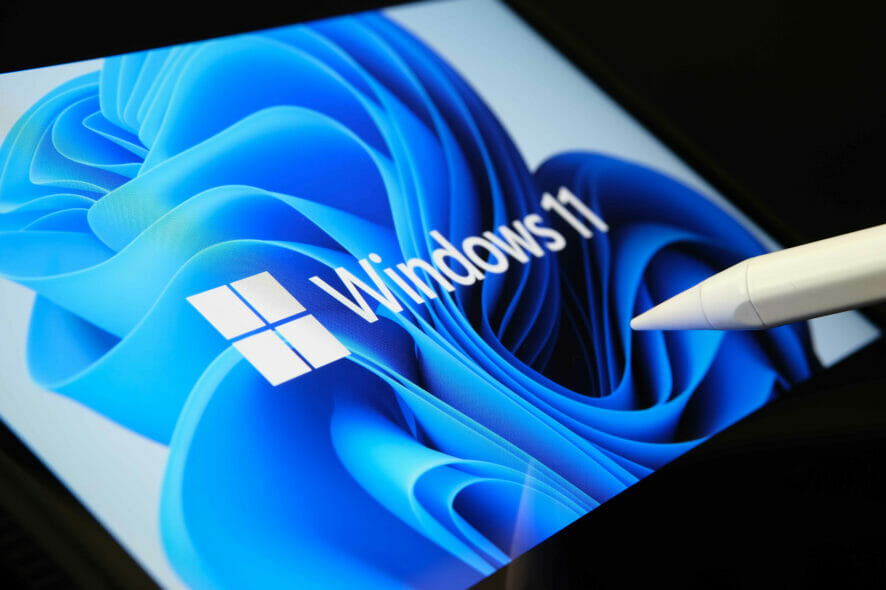
The following research has been compiled from the opinions of 11,097 readers who completed our opt-in online survey over the course of three weeks. Almost 45% of answers were recorded from the USA and India, while the next most popular countries were the United Kingdom, Canada, and Australia. Their unaltered answers are presented below.
Windows 11 is official, but the final version is months away. For now, the information laying around on Microsoft’s blogs and on the web hints at a release sometime in October, with a wider spread in 2022. And that’s perfectly fine, taking into consideration the latest builds.
Here, at WindowsReport, we like to think from the consumer’s perspective. That’s why we are determined to find out everything we can about Windows 11, starting with your genuine opinion about it.
After our first exclusive survey about Windows 11, we’ve learned that consumer expectations when it comes to performance and design are pretty big. We’ve also seen your interest in privacy, security, and Windows 11-ready devices. Our goal is to make sure that your feedback makes its way to Microsoft and your voice is heard.
To make that happen, we’ve decided to dig a bit deeper and find out your unfiltered opinion about Microsoft’s newest OS. Our first Windows 11 survey was about opinions, while the current one is about facts. Even more, is about your experience with the OS after the official announcement.
We’ve already gone through several Windows 11 builds already; some more polished, others not so much. But that is more than enough for Windows 7, 8, and 10 users to make a good idea of what’s to come. First impressions remain polarizing, especially now with so many new apps and features.
Some of the polled users are Windows Insiders and we’re also part of the same category as our experts installed the first build from day one and tested it thoroughly. This way, we’re making sure that our results are consistent and you get the best info available on the web.
Without further ado, let’s see where Microsoft’s upcoming OS shines and where it could improve.
Windows 11 is halfway there, design-wise
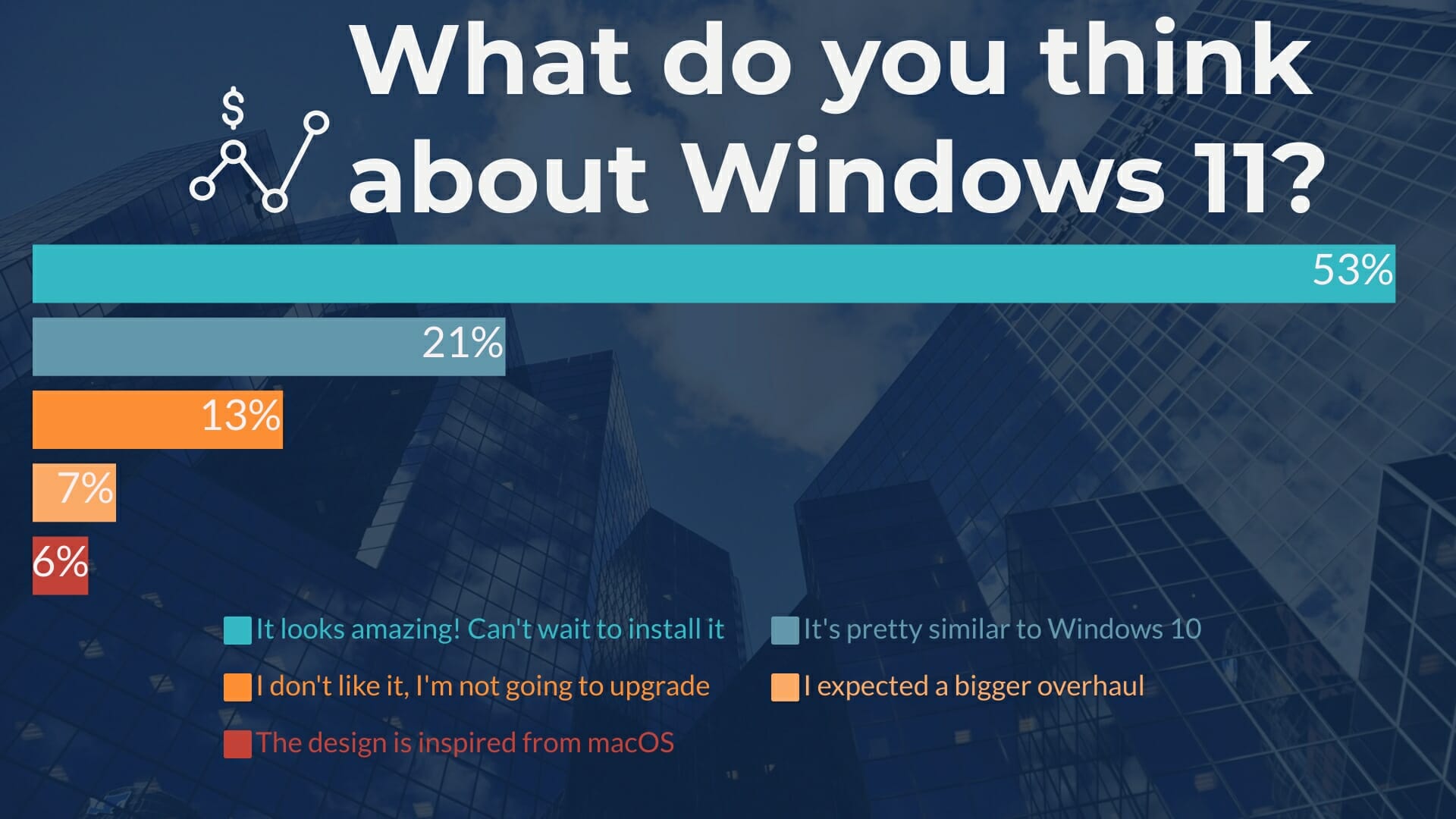
If you’re one of those users who know what Windows NT or Windows 95 were, then you can surely appreciate the year-by-year changes to Windows and most of Microsoft’s apps, even though some were less inspired. Windows came a long, long way, there’s no question about it.
After a mild failure in the form of Windows 8 & 8.1, Microsoft paid a lot more attention to user feedback and the much-improved results are now visible with Windows 10 and Windows 11.
Almost half of the respondents don’t like the new look
Microsoft’s latest OS, Windows 11, comes with a plethora of interesting features, improvements, and optimizations, but it seems that now, the tech giant made some big adjustments when it comes to the UI.
One of the most controversial changes is the centered Start Menu. While for some this was a long-awaited improvement, for others is a straight-up downgrade. This is also the main reason why 6% of the respondents think that Windows 11 took some bits and pieces from macOS.
The no-sayers continue with 7% of users who expected a bigger overhaul, 13% who don’t like the new look, and a pretty interesting 21% (which is a big enough percentage, we might add) of users who think that Windows 11 is too similar with Windows 10.
These results are also confirmed by our constant research on forums and websites and aren’t unexpected, considering the polarizing look and feel of Windows 11.
From what we’ve gathered online, there are only two sides to this story: you like it or you hate it. Luckily enough, the Redmond giant is giving you the option to revert to your previous OS, but only in the first 10 days after the upgrade.
More than half of polled users will update to Windows 11, despite the wave of denial
Yes, we can agree, the new design isn’t for everyone. But if you take into consideration the results above, alongside 53% of respondents that are eager to update, the numbers seem to add up in Microsoft’s favor (and in this case, also in the user’s favor).
Why? Well, the explanation is pretty simple: if more than half of the people who completed our survey like the changes and the UI in the current state, the number can only grow when the OS will be generally released.
Think of it this way: Windows 11, at this moment, is available only for Insiders; these early builds still have problems, bugs, and unfinished UI. The general release is scheduled for this autumn, with a wider spread in the spring of next year.
Despite the fact that many users are against Microsoft’s design changes, the numbers tell a completely different story. Windows 10, Windows 8, or even Windows 7 are some good examples of controversial design changes, but the Windows community was a lot less willing to upgrade from the start.
That’s why Windows 11’s high level of acceptance is a very good sign for the tech giant. Also take into consideration that things can only improve from here on, with a consistent design language and more exciting features along the way.
What are the most exciting new features in Windows 11?
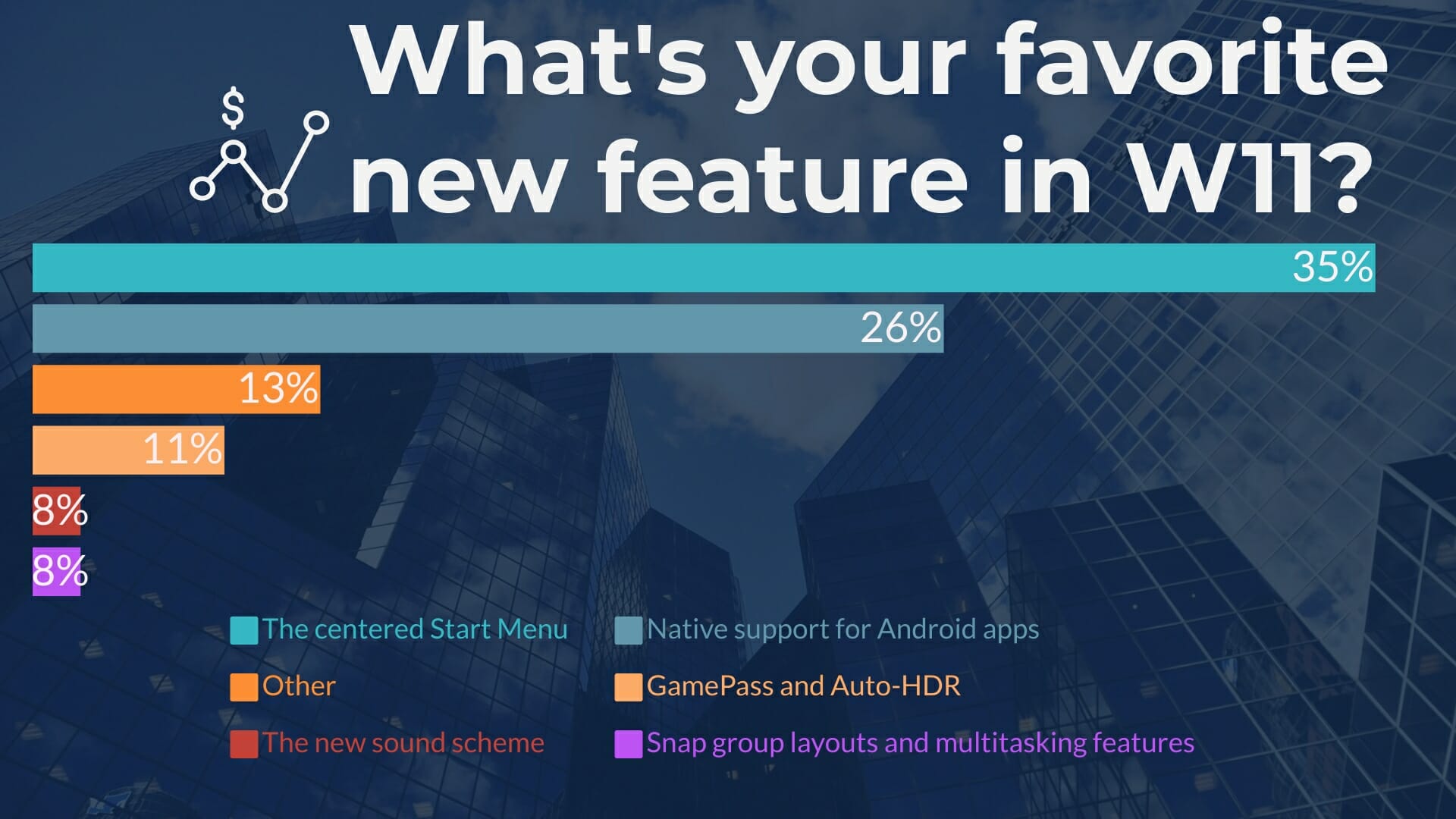
When we’re talking about operating systems, the feature set is probably the most important thing to take into consideration, besides the usability and the design. In that regard, Microsoft’s newest OS gets the job done with flying colors.
Rounded corners, more fluid animations, and a minimalist look are the highlights design-wise. Some are calling it a simpler design while others think that it’s a logical continuation of Microsoft’s fluent design language.
The new optimizations and the improved performance are also great things to get excited about. It’s still early to say for sure, but it seems that Windows 11 could be the go-to gaming OS. DirectStorage and Auto HDR are just a couple of big changes that will most certainly have a big impact.
Despite that, only 11% of respondents are interested in gaming features, with a mere 8% in the new multitasking features.
This is quite unusual (don’t you think?) and interesting at the same time, considering the efforts that the big M is investing in revamping Microsoft Teams and Office 365.
The centered Start Menu takes the cake
As controversial as it is, the big winner is the centered Start Menu, with an overwhelming 35% among other notable new features.
The departure from live tiles, the new rounded design, and the grid view is exactly what most Windows users were expecting. And that’s not all because the Search implementation makes much more sense now.
All of these changes have a very important thing in common: quick access. That’s why the layout of the redesigned Start Menu includes a Pinned and a Recommended section.
With all this interest around this important change, we’ve kept a close eye on all the Windows 11 builds in the Dev channel and especially on the Start Menu development. While on the first build there were some bugs and problems, now, things look a lot cleaner.
And if the tech Redmond giant is focusing so much on this new feature, it has to be for a reason, right? And this reason is simple: the end-user.
Native Android app support is a close second
Another great feature focused on the end-user is native app support in Windows 11. Yes, we agree, it took a very long time to implement this, but now it seems closer than ever. 26% of respondents are eager to get their hands on Android apps directly in Windows 11.
Despite the fact that the apps will be installed on your device through the Amazon Appstore, it’s a good enough start for most users.
Remember Microsoft’s partnership with Samsung? That was the company’s first try to make the interaction between your phone and PC seamless. YourPhone app has a lot going for it, but it’s still missing some key features and this is exactly the reason why many Windows 10 users have an emulator installed on their device.
This new feature, allegedly, will let your run most Android apps natively on Windows 11. This is a new opportunity for developers, as interest is growing every day, but we’ll have to wait and see how the final version will look like on the general release of Windows 11.
In the meantime, there’s a lot of chatter about sideloading apps on Microsoft’s latest OS, but this might prove to be a lot more difficult than initially predicted. The reason behind this is the new Android format, AAB (Android app bundle).
Google’s decision to switch from .apk to AAB just before the general release of Windows 11 is controversial, but this won’t affect the way Android apps work as Amazon is promising AAB support for Microsoft’s latest OS.
As always, there are two sides to the story and the big losers in this scenario seem to be emulator developers. At the moment, you can run android apps on your PC through an emulator. If Microsoft’s native implementation works as intended, emulators will become obsolete.
This subject sparked our interest, so we decided to talk to some emulator developers who are convinced that Windows 11 users will continue using emulators. Why? Well, because most emulators will have extra features and better app support, along with the possibility to install any Google Play app.
Windows 11 bumps up the number of Insiders
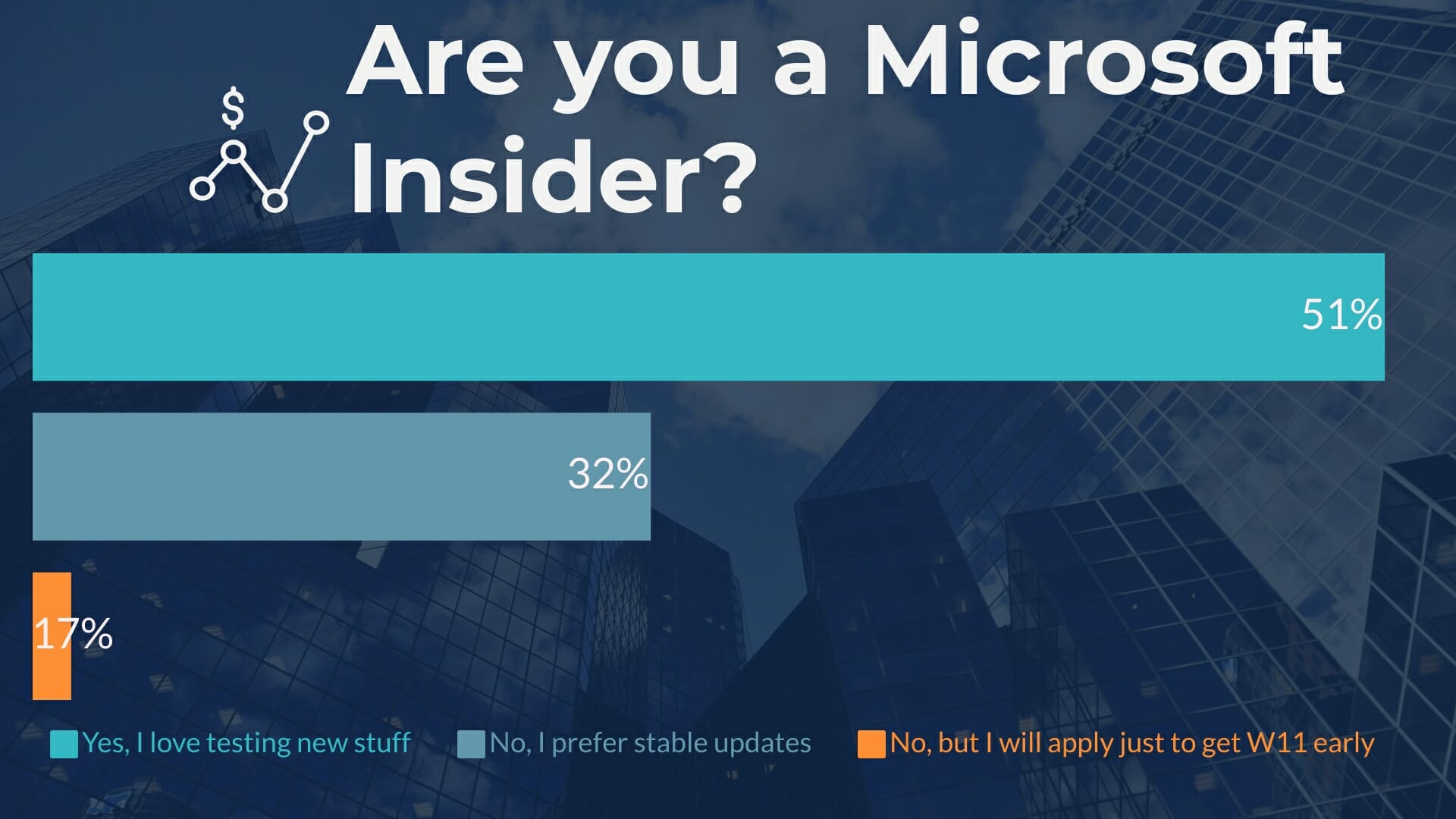
If you’re not very familiar with Microsoft’s Insider program, there’s a good chance you’ll learn more about it if you really want early access to Windows 11. To keep things short, the Insider program lets you test the latest builds, apps, and changes to everything Microsoft-related.
But keep in mind that we’re talking about alpha or beta testing, so there’s a good chance to encounter bugs, issues, unfinished design, or poor stability.
The good part is that you can be directly involved in the development by testing the new features and then leaving feedback in the Feedback Hub (call it a direct line to Microsoft’s devs, if you want).
Here, at WindowsReport, we’ve been Insiders for most of Microsoft’s programs and operating systems, but Windows 11’s Insider program is by far the most interesting.
Windows 11 made 17% of respondents become Microsoft insiders just to test it out sooner
And it seems that some of those who took our survey feel the same, with their number growing every day. 17% of respondents are determined to become Insiders just to get their hand on Windows 11 earlier.
While it might not seem that much, keep in mind that these 17% are willing to install an early build of Windows 11 and test it out, with all its bugs and inconsistencies, with some of them using it as their daily driver.
This clearly shows that people are interested (some might say intrigued) by Microsoft’s newest OS and want to test it out and even build alongside the devs with precious feedback and out-of-the-box ideas. Hopefully, the end result will be a tailored experience for most of those who are part of the Windows community.
These numbers are quite unexpected, but at the same time, promising. More testers means more feedback; if the Redmond devs are listening, this feedback could very well shoot Windows 11 to the top very fast.
If you’re interested in the Windows Insider program, go through Microsoft’s documentation to find out everything you need. But if you want to know what to expect, take a look at our latest Windows 11 build review. You’ll find many interesting features but also some pesky bugs that might be your deal-breaker.
Microsoft’s system requirements fall heavy, as a quarter of users don’t pass the official test
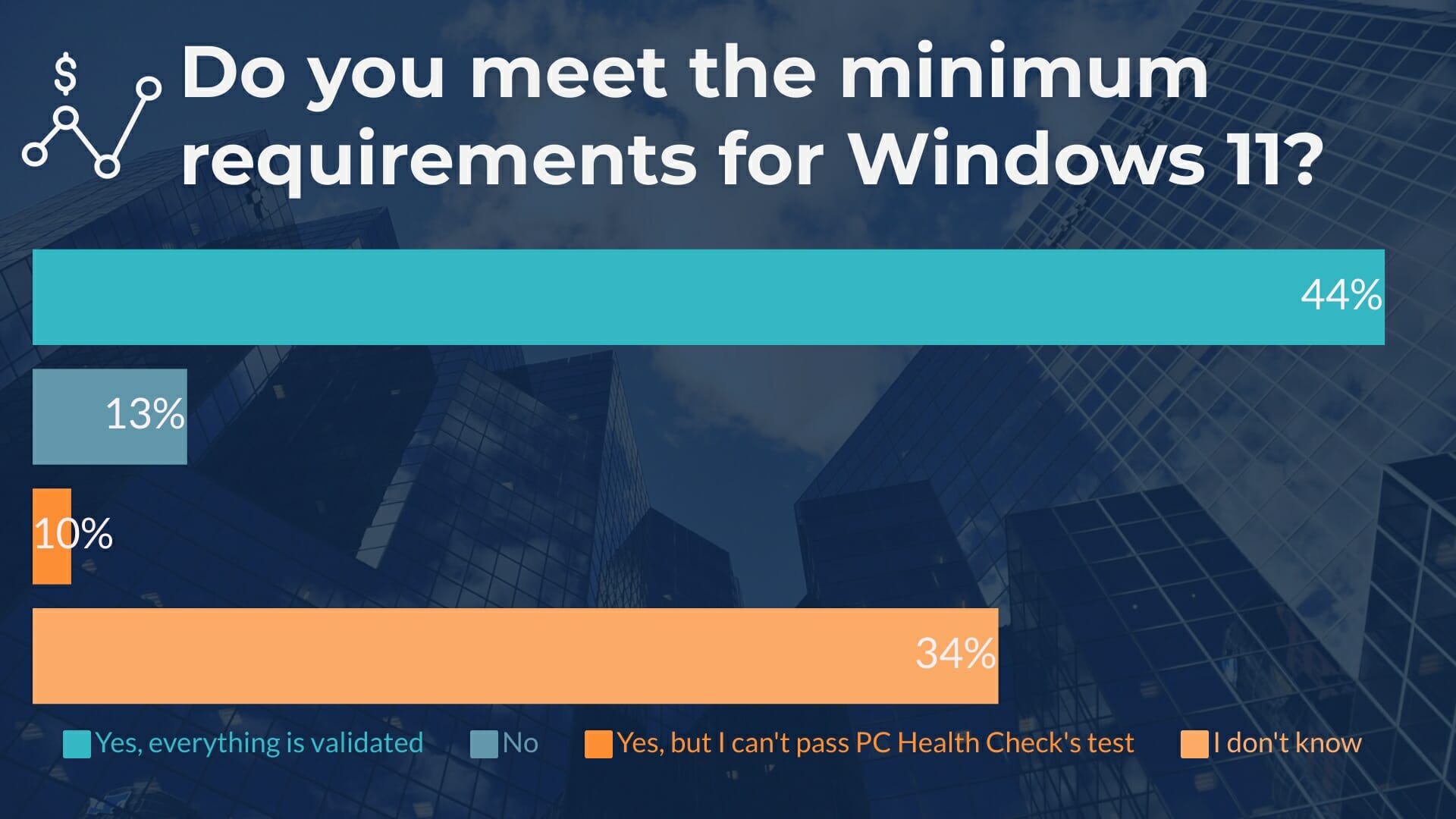
Is your PC compatible with Windows 11? If you don’t know the answer to this question, don’t worry, you’re in the same boat with 34% of respondents. Maybe this is a sign that Microsoft should make things clearer when it comes to hardware and software requirements. Or simpler.
Whatever the case may be, know that there are dedicated programs that will handle this check for you. Microsoft’s own PC Health Check app is the first example, but for now, the app is not available due to some problems with the compatibility check.
Other good alternatives are the WhyNotWin11 or the CheckIt app.
On the other side, if you know everything about your PC and you’ve already confirmed the compatibility, 44% of respondents have done the same.
The interesting number is 10%, because that’s the percentage of users that answered our survey and have compatible PCs, but can’t get past the PC Health Check app. The main reason is the TPM 2.0 chip. Most new PCs come with TPM 2.0 already installed but it seems that some of the older ones that have TPM 1.2 won’t be able to run Windows 11.
Adding this up with the 13% polled users who can’t upgrade their devices and we get a staggering 23% (almost a quarter of respondents) who can’t or won’t upgrade to Windows 11.
Keep in mind that this is a real problem and the Redmond giant takes it seriously, as the callback for the PC Health Check app indicates the same. We’ll see in the near future if the initial requirements were just a mistake or maybe a powerplay from Microsoft
Things are a bit unclear, for now, and the big M is making some adjustments to clear things up. At this time, the available info suggests that TPM 1.2 devices will also be supported, but will find out more once the PC Health Check app will be again available to download.
In the meantime, if you want to find out more about TPM 2.0 and TPM 1.2, we’ve made a full comparison between them and found out the main differences and similarities.
42% of our respondents don’t know what a TPM chip is
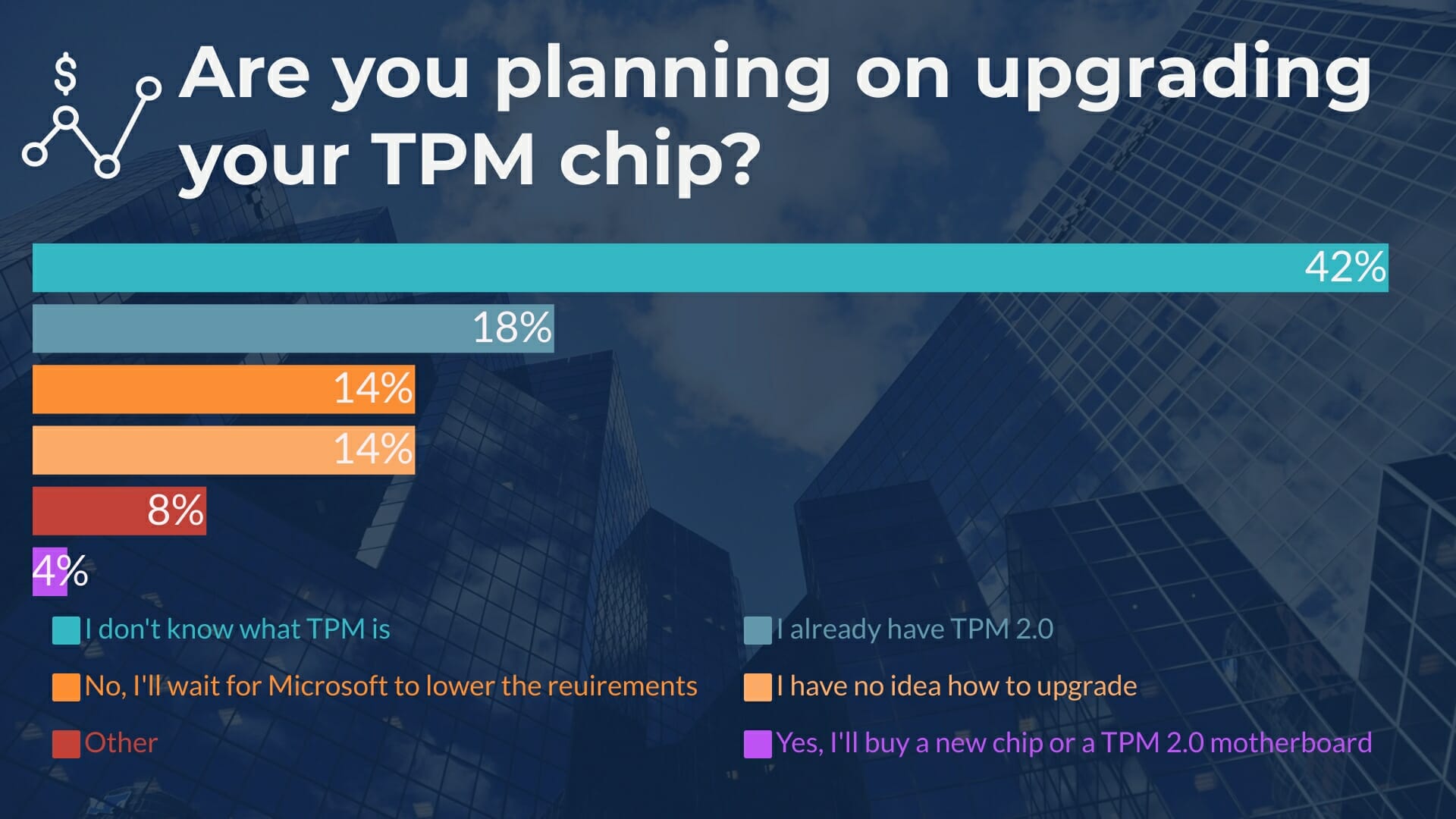
TPM (Trusted Platform Module) is a small microcontroller (chip) that provides encryption features. Simply put, TPM improves your PC’s security. The first version, TPM 1.2, was released in 2005, and the second version, TPM 2.0, was initially released in 2014.
If you’re wondering why we’re explaining this, that’s because almost half of the respondents don’t know much about TPM. And that’s perfectly normal because the average user doesn’t need this additional info.
The catch, however, is that one of Microsoft’s requirements for Windows 11 is TPM 2.0. This means that you can install the OS on your device only if you have this chip installed. Because this specific requirement created a lot of confusion in the Windows community, Microsoft is now working on improving the check-up process and it is possible that in the future TPM 1.2 devices to also pass the check.
Until then, if you’re looking for some Windows 11-ready laptops, we’ve already found some of the best right now. The list will grow over time, as more similar devices will hit the market.
Among those who answered our questions, 4% are most likely desktop users that are willing to buy a TPM 2.0 chip or a compatible motherboard that already has one and upgrade their rig.
Tablet PCs might be out-of-stok this holiday season, buy yours now!
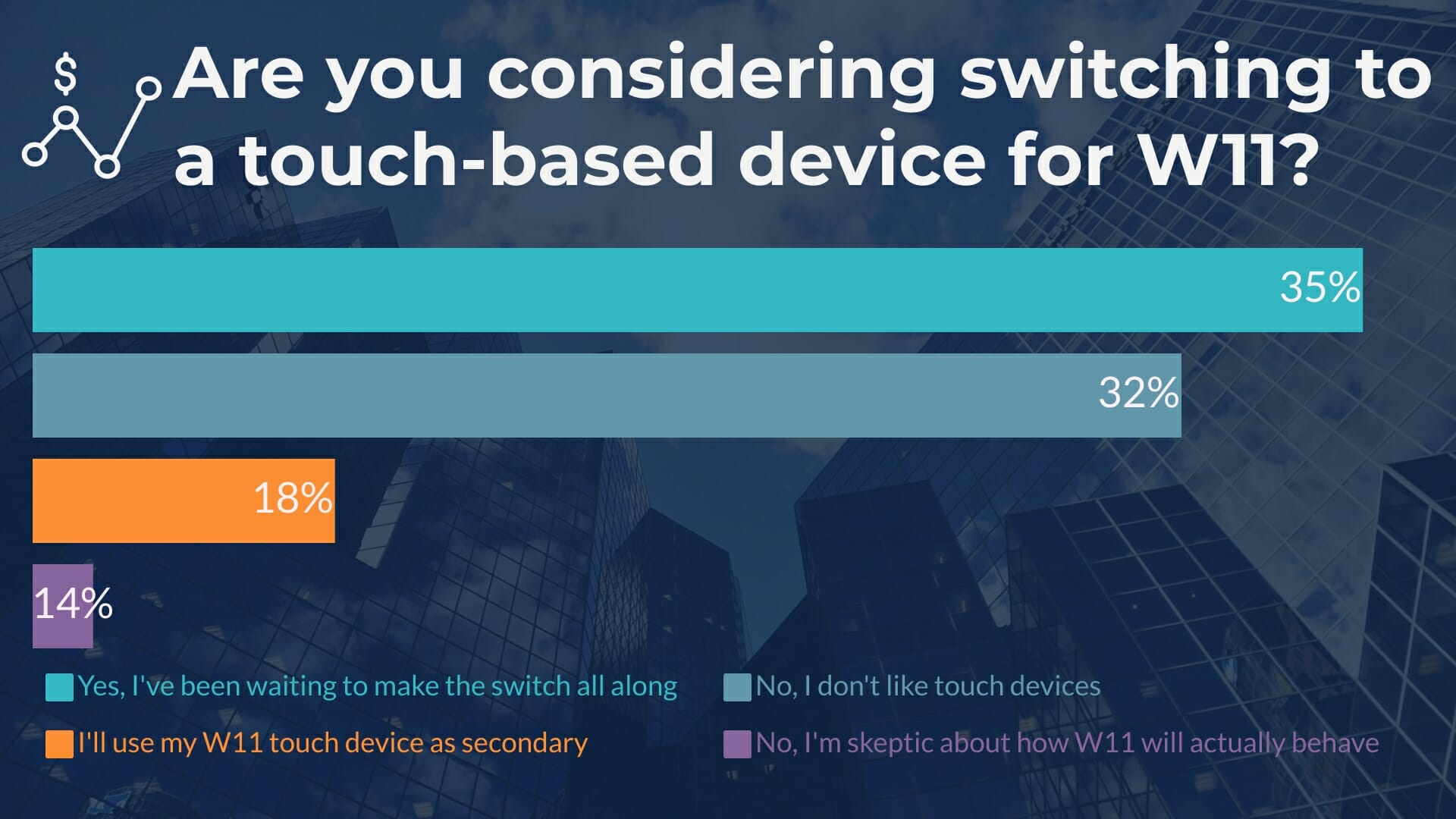
When it comes to touch-based devices, people always seem to love them or hate them. And in this category, we can include tablets, laptops with touchscreen, 2-in-1’s, and even smartphones (remember Microsoft Surface Duo?).
This conclusion is further confirmed by our survey, as 32% of respondents are not interested in switching to a touch-based device while 35% of them were waiting for the proper operating system to do so. And from what we’ve gathered so far, it seems that Windows 11 might just be that proper OS.
While laptops and desktops have seen constant growth over time, touch-based devices (especially tablets) have become less and less popular. One of the main reasons for that is the limited productivity and software limitations – because the hardware was always on point, with specs that easily surpass an everyday laptop.
The idea of a full-blown OS on a tablet is not new, but for some reason, it seemed unpractical. App compatibility and laptop-tablet workflows are just two of the main drawbacks, but the list can easily continue with UI/UX optimizations and a lackluster multitasking environment. All this could change with Windows 11.
A third of respondents are willing to switch to a touch-based device, once Windows 11 gets out
This sentiment is shared by more than a third of polled users who want to make the jump to a touch-based device when the new OS will be widely available.
This is a bit surprising, but taking into consideration the way Windows 11 looks and feels, it makes a lot of sense to use it in a touch-based environment.
Microsoft’s Surface lineup is a very good starting point, with devices ranging from basic day-to-day use to more powerful, professional devices targeted at creators. And there’s a good chance that Windows 11 will be compatible with all of them.
Of course, numbers don’t mean much without context but seeing that a third of current users are willing to make the jump to a touch-based device thanks to Microsoft’s latest OS should raise some eyebrows, especially if we’re talking about tech manufacturers.
We might just see an increased number of devices hitting the shelves this holiday season, with most of them being Windows 11-ready devices.
Some users are waiting for the official release to make an opinion, with 14% being skeptical about the final version of the operating system. But if most of what we know today about Windows 11 will make its way to the general public, we think that it will run very well on a touch interface.
Internet Explorer, Snipping Tool, and Skype will be missed by half of Windows 10’s userbase
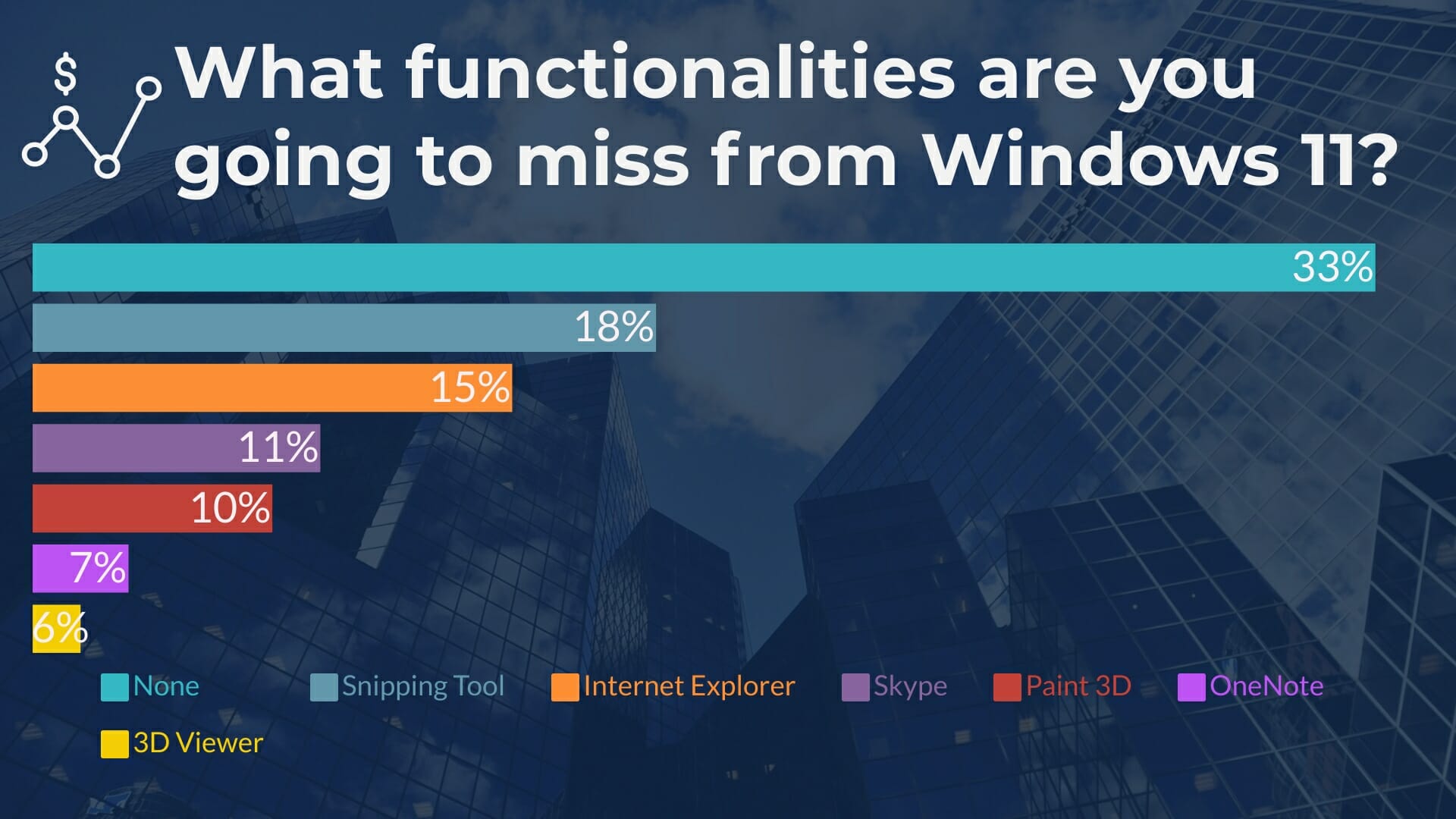
As we already know, with the new changes and feature set, Windows 11 makes a leap in the future. This means better optimization, faster integration, and improved usability.
With this in mind, some of the legacy apps will be left behind and replaced with better versions. To name a few important ones, we’re talking about Snipping Tool, Internet Explorer, Skype, Paint 3D, OneNote, and 3D Viewer.
For now, these apps won’t be completely removed, but just disabled by default. We’ve already tinkered with Windows 11 and found some ways to enable them back, but do you really want to do that?
Think of it this way: if Microsoft is offering support for Windows 10 until 2025, it’s possible that these apps will also get the same support. Also, in a future Windows 11 build, the company might remove them for good, not just disable them.
So there’s a good chance that you won’t be able to use them for much longer. Keep in mind that the tech giant is already offering some handy alternatives that could make your life much easier.
Internet Explorer is going to be missed by a whooping 15% of users
Coming back to those disabled apps, Snipping Tool is the winner with 18% of our readers wanting it in Windows 11. Internet Explorer is a close second with 15%, while Skype is only third with 11%.
Nowadays, there are a plethora of browsers that can do more than just browse the Internet, but we aren’t that sure that they should. With so many efforts from Microsoft invested in Edge, there are still many Internet Explorer fans out there.
The reasons for that can drastically vary, but the truth is that some just want to browse the Internet without much fuss while others are accustomed to the interface and the features; and can you blame them?
Despite already being a legacy app, IE is the go-to browser even for some Windows 10 users, with those who still use Windows 7 completing the list. The chances to see IE on Windows 11 are pretty slim, but Microsoft is making constant efforts in improving Edge and making it a worthy successor.
One thing is for sure: many legacy apps will be missed alongside IE. But another staggering number is 33%. This is the percentage of users who won’t miss any of Windows’ current apps.
Surprisingly, 57% of Windows 7 users are going to upgrade to Windows 11
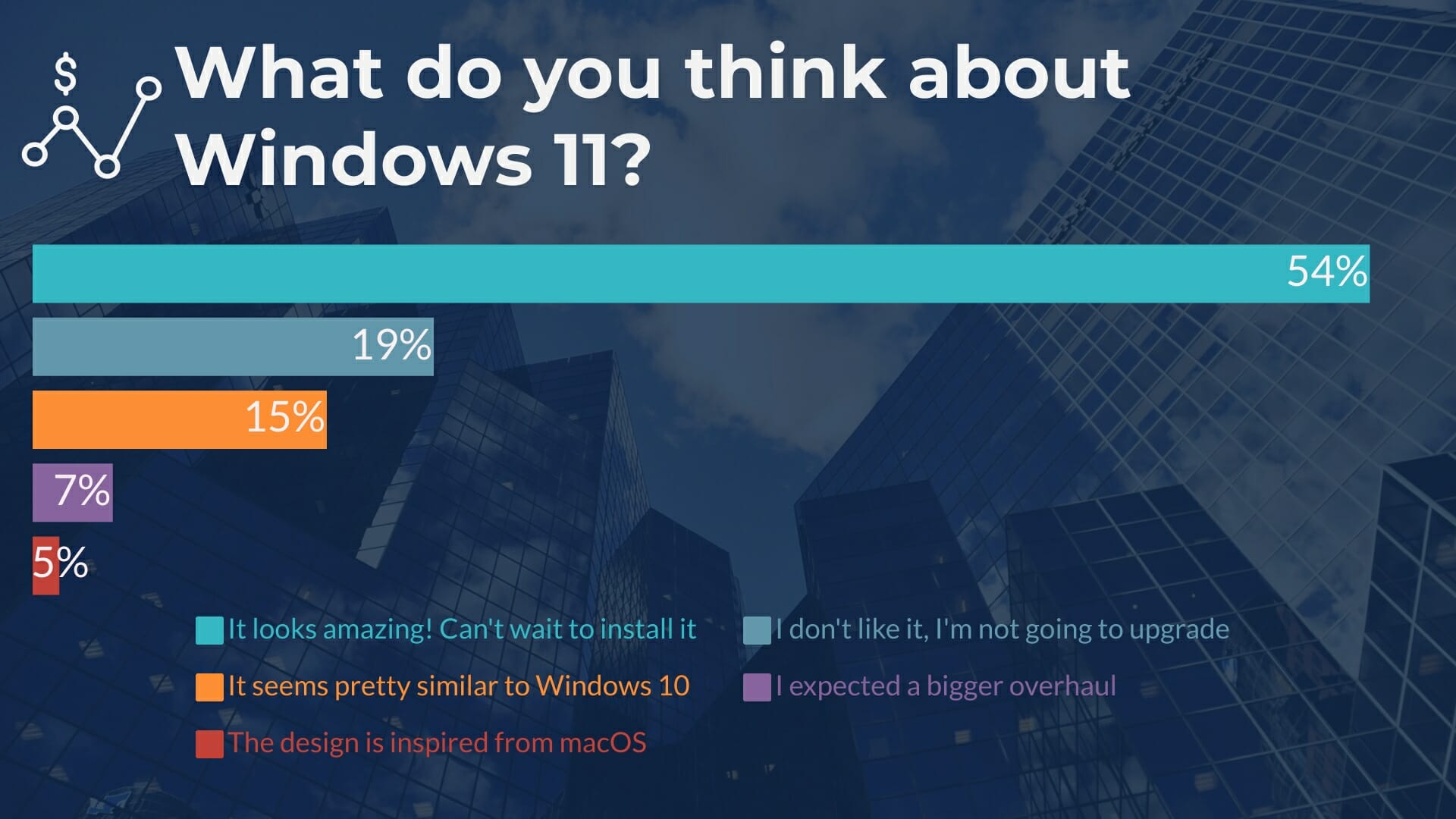
Our last exclusive Windows 11 survey brought up some very interesting results when it comes to Windows 7 users. The trend continues with 54% of the current respondents who are eager to update to Windows 11.
The centered Start Menu & design improvements seem to be the main reason for that, but we think that Windows 8 and Windows 10 weren’t convincing enough. The bloatware, bugs, and general instability are just some of the reasons why so many of them haven’t upgraded yet.
Microsoft’s latest OS seems to be the choice for most Windows 7 users, promising to solve all its predecessor’s problems.
The bigger question is what will happen with enterprises that rely on Windows 7 devices. As you might know, there’s a big difference between a Windows 7 home user and an enterprise one. We’ll have to wait and see if the companies are ready to make the jump to Windows 11 (and Windows 11-ready devices).
Most Windows 7 users have a modern PC, but resisted updating to Windows 10
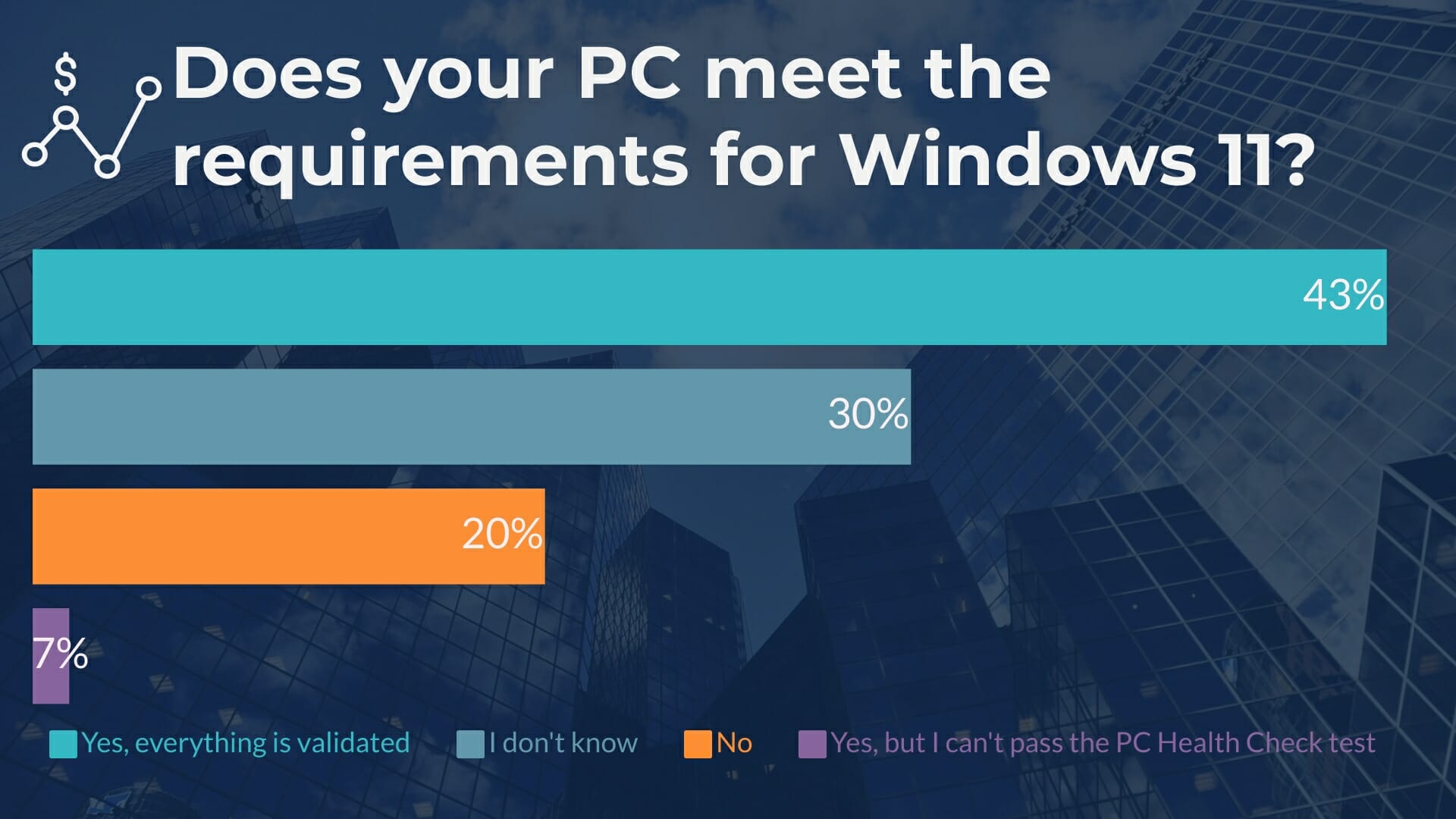
If you’re thinking that most Windows 7 users haven’t upgraded to a newer OS because of their device, you couldn’t be more wrong. Almost half of them have Windows 11 compatible devices, and this says a lot about their PCs.
Furthermore, this reinforces the statement above that Windows 7 users want a stable OS on which they can rely for their daily tasks.
Our research also showed that 46% of Windows 7 users are thinking of going for a touch-based device. From a macro perspective, these users should be on top of that 43% who already have a compatible device. This means that the number of users who are upgrading to Windows 11 could be much higher.
Internet Explorer will be missed by Windows 7 fans
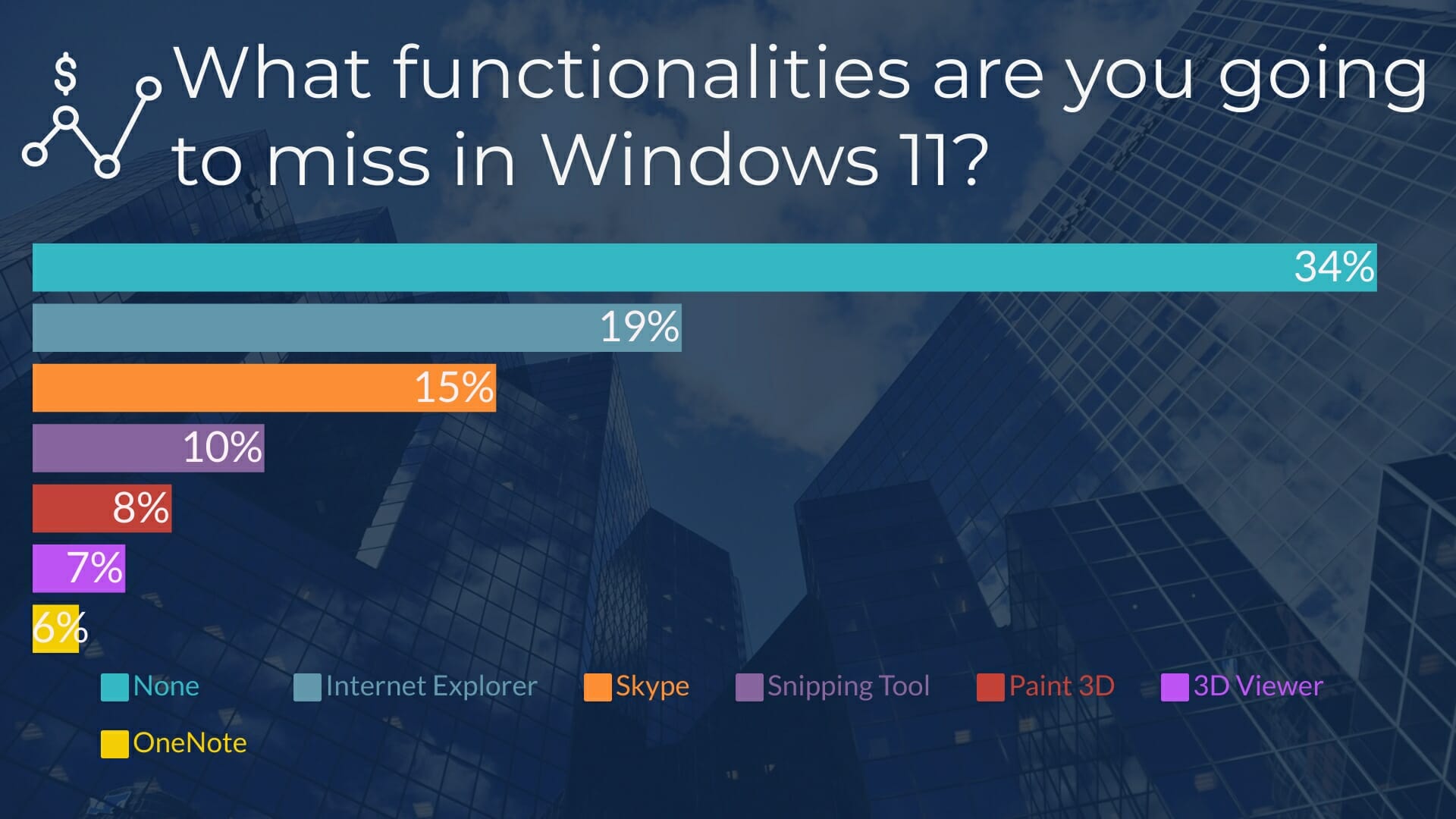
Internet Explorer is one of the oldest browsers out there, but it’s still used by a lot of users, especially on Windows 7. It has been a reliable tool for at least 19% of Windows 7 respondents and they’ll miss it the most on Windows 11.
Skype and Snipping Tool remain in the top 3, with 15% and 10% respectively.
The interesting swap between the Snipping Tool and Internet Explorer shows that most Windows 7 users aren’t ready for another browser, even though Microsoft is relentless in its efforts of bringing Edge to everyone.
If you’re an IE user, we’ve got good news and bad news: the good news is that Edge is getting a lot of new things, including optimizations, changes, and improvements with Windows 11. The bad news is that Internet Explorer mode will no longer be available on Edge.
Don’t forget to think about the security and privacy implications of using Internet Explorer. With Microsoft offering fewer and fewer paths of using it, maybe it’s time to consider the jump to Edge.
About the data
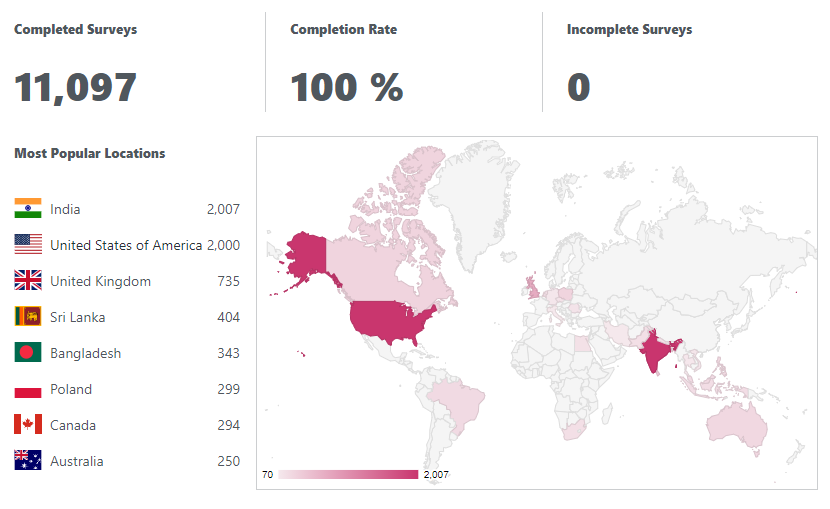
The research above was constructed based on the input of our readers through an online survey which ran for three weeks on WindowsReport.com. Using Crowdsignal, a popular survey tool, we have gathered 11,097 complete answers to all of our questions.
We’ve received answers from 177 countries, but the most popular locations were:
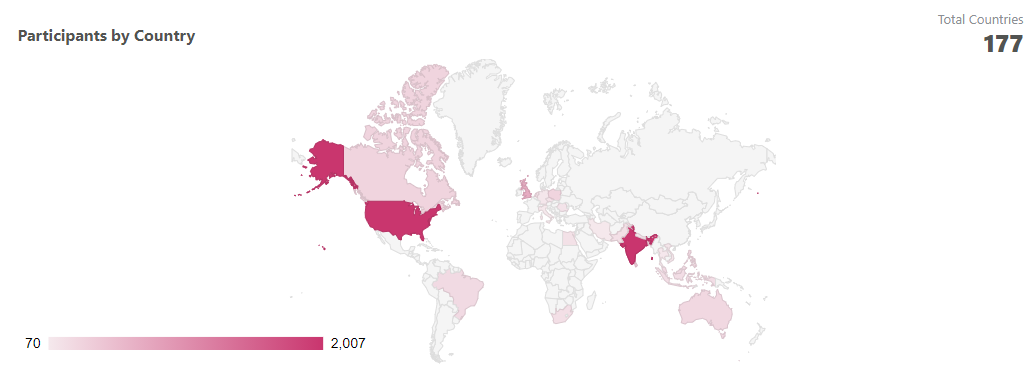
- India – 23%
- United States of America – 22%
- United Kingdom – 8%
- Canada – 3%
- Australia – 3%
When it comes to platform distribution, readers that have completed this survey are mainly using Windows 10. We’ve also recorded answers from people that are using Windows 7, macOS, Linux, or Chrome OS.

The raw-data used in the research above can be seen and downloaded here.
Our researchers
Passionate about technology, Windows and everything that has a power button, Vlad is the chief editor of WindowsReport.com. With a keen eye for fact-checking, Vlad is a constant watcher over the Windows world and all that surrounds it.
Author of over 140 computer trade books, including 60-plus titles on various certification topics, developer of over 70 online and classroom courses, Ed Tittel is an expert consultant on information security, markup languages, web development and networking technologies.
